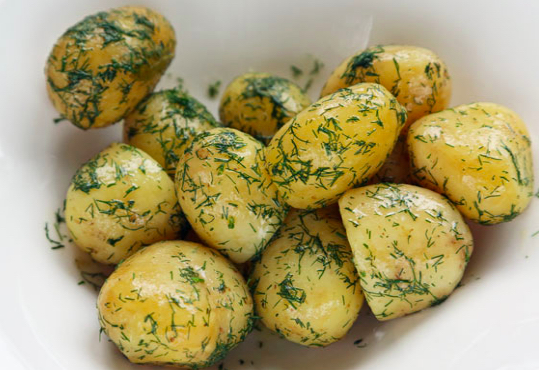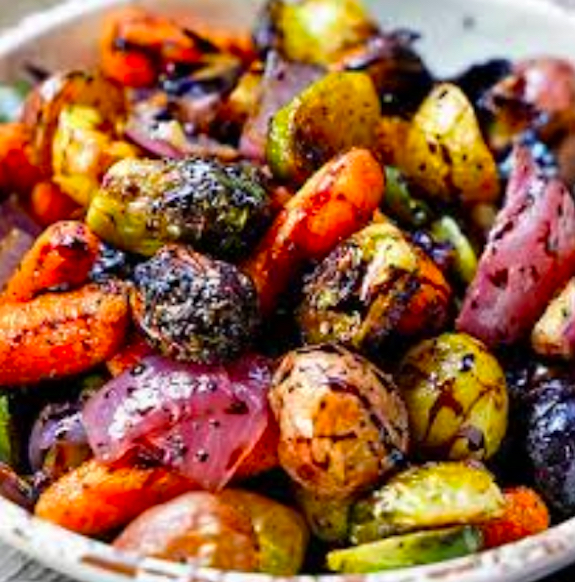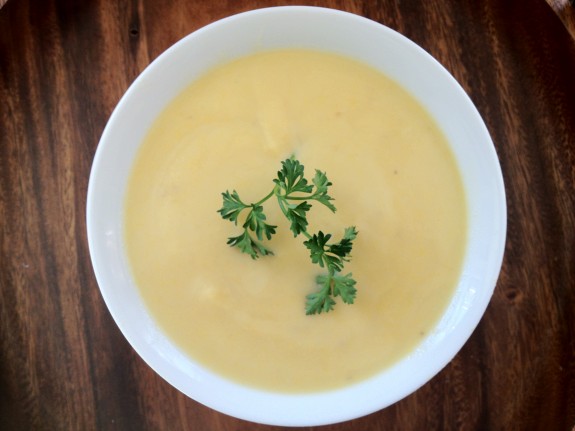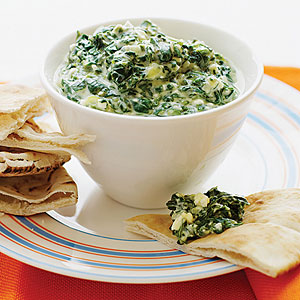Swedish New Potatoes with Fresh Dill
 Potatoes are delicious boiled, the simplest and fastest preparation. In Sweden, they are customarily eaten on the same fork as gravlax (cured salmon) and mustard sauce. The combination is delectable. Potatoes are a traditional Swedish dish and served with just about every meal. Historically, Sweden’s fruit and vegetable choices were limited because it lies so far north. Potatoes were an important source of essential vitamins and minerals, preventing lethal deficiencies. Today that legacy continues.
Potatoes are delicious boiled, the simplest and fastest preparation. In Sweden, they are customarily eaten on the same fork as gravlax (cured salmon) and mustard sauce. The combination is delectable. Potatoes are a traditional Swedish dish and served with just about every meal. Historically, Sweden’s fruit and vegetable choices were limited because it lies so far north. Potatoes were an important source of essential vitamins and minerals, preventing lethal deficiencies. Today that legacy continues.
Ingredients:
2 lbs. small thin-skinned “new” potatoes**
1 dill stalk
½ tsp salt
¼ stick butter (2 Tbsp)
2 Tbsp rock salt or Kosher salt
freshly ground black pepper
Two to four Tbsp fresh clipped dill, to taste
Instructions:
1. Wash the potatoes. Just scrub them if you’d like to keep the skin on. Or scrape off the skins if you wish. Rinse the potatoes.
2. Place the larger potatoes over the base of a saucepan and pop the smaller ones on top. Pour in enough boiling water to not quite cover them, add some salt and the stalk of dill.
3. Cover with a tight-fitting lid and simmer gently for between 10 and 20 minutes. The cooking time depends on the variety and size. Test them with a skewer as they must be tender but still firm—overcooking really does spoil them.
4. Drain the potatoes and add the butter, the chopped fresh dill and a little pepper to the pan and then return the potatoes to the pan. Put the lid back on the pan and swirl the pan around to get each potato thoroughly coated.
5. Remove the lid, savor the delicious aroma and then sprinkle with a little rock or Kosher salt before serving them.
** “New” potatoes are freshly harvested young, or small, potatoes. They are the same varieties as their larger counterparts, but are harvested earlier in the season when they are sweet than their older counterparts. Also, because these potatoes are harvested young, their skins are very tender and flaky.
Roasted Vegetables: I Promise They’re Tastier Than French Fries!

Roasted Vegetables, if done correctly, become caramelized, golden brown, and taste better than french fries. They also create an artistic presentation. Photo by KevinIsCooking.com
If roasted correctly, this stunning rainbow of vegetables can taste better than french fries. Yes. You heard me! Roasting for the ideal length of time caramelizes vegetables, conveying sweetness and expressing more of their aromatic flavors. They are crispy and golden on the outside with a tender inside. The array of vegetables satisfies your natural urge for a variety of color, texture, flavor and shape, leftover from cave man times, all of which, together, help prevent cravings and provide an array of nutrients, important for survival. Even in today’s space age, you still have that instinct for variety. Add a fruit, such as apples or peaches to create more sweet, if you wish.
My fourth weekly batch recipe, based on what you can find at your Farmers Market this weekend (beets, carrots, potatoes of all kinds, broccoli, and brussels sprouts), is Tastier Than French Fries! Roasted Veggies.
Batches are all about making the most of the time you spend in the kitchen and easing some stress from your life. I feature batch recipes in my books, Diet Simple and Diet Simple Farm to Table Recipes. Batches are your favorite delicious, quick and easy meals made ahead of time so that you always have something in the freezer or refrigerator, ready to eat, or serve for guests, on a moment’s notice. And, believe it or not, though it may take a little extra time to prepare the batches on the weekends, it actually saves time overall and calms the daily whirlwind of your life.

Beets, Carrots, Yukon Gold Potatoes, Brussels Sprouts, and Broccoli Create a Rainbow of Colors, Textures, Shapes & Flavors
Tastier Than French Fries! Roasted Veggies
By Katherine Tallmadge
Use this side dish with anything. It creates a colorful, artistic presentation and adds an assortment of flavors, shapes & textures, delightful to all palates. You can also use them cold in a salad, toss them in a soup, or add them to an omelette. They’re a great batch; they should last for a week.
Some roast better than others, such as cauliflower, brussels sprouts, carrots, beets, mushrooms, winter squash, tomatoes, onions, eggplant, bell peppers, and of course, we all know about potatoes!
1. Preheat oven to 400 degrees Farenheit,
2. Select the combination of vegetables you’d like to roast.
3. Cut the vegetables (and fruits, if used) in similar size pieces so that they cook evenly,
4. Place in a large bowl or plastic bag, add canola oil (it won’t burn at a high temperature like butter or olive oil), salt, pepper, and an herb of your choice, such as fresh Rosemary,
5. Toss or shake until all vegetables are coated (but not too greasy). Pour off any excess oil,
6. Place on a cookie sheet or baking pan covered with aluminum foil or parchment paper (prevents sticking to your pan), and place on the center rack in your oven,
7. Roast for 30 to 45 minutes, tossing the vegetables or shaking the pan occasionally to cook evenly,
8. Roast the vegetables until they are golden brown on the outside, but tender in the center – like a french fry!
9. Different vegetables, cut in varying sizes will take a longer or shorter time to reach perfection.
Katherine’s Market Recipe: Cauliflower “Vichyssoise”
- At October 23, 2012
- By Katherine
- In News, Recipes
 0
0
“Thank you for the best soup we’ve had in ages. I love it! And I hate cauliflower!” said my neighbor Nancy Flinn. A client’s teenaged son even asked for 2nd and 3rd helpings. That’s why this is one of my favorite soups. It’s adapted from “The French Culinary Institute’s Salute to Healthy Cooking,” an inspirational cookbook for me. A “Vichyssoise,” is normally cold, but I recommend you serve this hot. A traditional vichyssoise is made with cream, potatoes and leeks, but I think you’ll love this version even more – made with the more flavorful cauliflower, a little potato lending texture, and milk making it lusciously smooth.
Today is the 10th “Katherine’s Market Recipe,” all of which are designed to be delicious, easy, quick, family-friendly, nutritious (heart-healthy & diabetes-friendly), and to highlight produce found at our local Farmers Markets this week. At your Farmers Market, you’ll find produce picked at peak ripeness, which means maximum flavor, texture and nutrition. You’re also helping save the environment when you buy at your Farmers Market. Here’s how…
For my “Cauliflower Vichyssoise,” I recommend you buy the cauliflower, leeks, and potato at Georgetown’s Rose Park Farmers Market (there are only two market days left!) on Wednesday or Dupont Circle’s Fresh Farm Market (open year-round) on Sunday.
Cauliflower “Vichyssoise”
By Katherine Tallmadge, M.A., R.D.
Cauliflower is in the species of foods called “brassica.” The brassica family of foods has extremely high nutritional values and contain high levels of antioxidants and nutrients such as vitamin C, selenium, calcium, potassium, folic acid and choline – important for the brain, as well as soluble fiber, which reduces cholesterol and helps level blood sugar. Brassica, a huge category of foods including broccoli, cabbages, mustard seeds and greens, also contain potent anti-cancer compounds which help detoxify carcinogens in the liver before they continue to circulate in your bloodstream. These compounds also aid your immune response with anti-viral and anti-bacterial properties.
4 to 8 Servings
Ingredients
1 Tbsp Canola Oil
2 Leeks
1 Head Cauliflower
1 Medium Potato
6 Cups Chicken Stock (or vegetable stock), fat removed
1 Cup 1% Milk
Salt and Freshly Ground Pepper
8 leaves Fresh Parsley, Chopped
Slice the white part of the leeks, cut the cauliflower into florets and set aside. Heat canola oil in an iron skillet over medium heat. Add sliced leeks, stirring frequently for about ten minutes until soft. Stir in the stock, cauliflower and potato. Reduce the heat, cover and simmer for about twenty minutes or until vegetables are soft. When mixture has cooled a bit, puree with the The Cuisinart Smart Stick… No mess, no fuss! (or blender or food processor), add the milk. Serve hot in the cool weather, cold in the hot weather. Add salt and freshly ground pepper to taste. Garnish with chopped parsley.
700 calories in the entire pot of soup
7 So Called “Bad” Foods That Are Actually Good For You
- At May 23, 2012
- By Katherine
- In Articles, News
 5
5
Are you shying away from bad foods that are actually good for you? With all the hoopla about healthful eating, it’s hard to separate fact from fiction.
As a nutrition consultant, I’ve come to realize there is no shortage of surprises and superstitions in the world of nutrition. As a follow-up to my recent Washington Post article, “5 So-Called Health Foods You Should Avoid,” I thought it would be fun to give you reasons to enjoy some of your favorite so-called “bad” foods that could actually be good for you, originally published in The Washington Post…
Gluten and Wheat
They are “the most demonized ingredients beyond high fructose corn syrup and hydrogenated oil,” said Melissa Abbott, culinary director at the Hartman Group, a company specializing in consumer research.
Yet decades of studies have found that gluten-containing foods, such as whole wheat, rye and barley, are vital for good health, and are associated with a reduced risk of diabetes, heart disease, cancer and excess weight.
“Wheat is a good source of fiber, vitamins and minerals,” said Joanne Slavin, nutrition professor at the University of Minnesota. She added that the confusion about gluten, a protein, has caused some people to avoid eating wheat and other grains.
Only about 1 percent of the population – those with celiac disease or wheat allergy – cannot tolerate gluten and must eradicate it from their diet to ease abdominal pain and other symptoms, including the ability to fully absorb vitamins.
One reason wheat-free or gluten-free diets are popular is that people who don’t eat wheat often end up bypassing excess calories in sweets and snack foods. Then they start feeling better, lose weight, and mistakenly attribute their success to gluten or wheat avoidance. Learn more about a gluten free diet and who may benefit from it…
Eggs
Eggs also don’t deserve their bad reputation. In recent decades, their high cholesterol content has been thought to play a role in increasing LDL (“bad”) cholesterol and heart disease risk. But cholesterol in food is a minor factor contributing to high blood cholesterol for most people, and studies have not confirmed a correlation between eggs and increased heart disease risk. The major determinant of LDL (bad) cholesterol is saturated fat, and while eggs are high in cholesterol – 184 milligrams in the yolk – they’re relatively low in saturated fat – about 1.6 grams in the yolk.
Interestingly, some of the biggest egg eaters in the world, the Japanese, have low cholesterol and heart disease rates, in part because they eat a diet low in saturated fat. In contrast, Americans eat eggs alongside sausage, bacon, and buttered toast.
“The amount that one egg a day raises cholesterol in the blood is extremely small,” says Walter Willett, professor of epidemiology and nutrition at Harvard’s School of Public Health. “Elevations in LDL (bad) cholesterol of this small magnitude could easily be countered by other healthy aspects of eggs.” Learn more about eggs…
Potatoes
Potatoes have been blamed for increasing blood glucose levels, insulin resistance, excess weight and Type 2 diabetes. A recent Harvard study that followed large populations and their disease rates linked potato eating with being overweight, blaming it on the blood glucose rise.
But many foods, including whole-wheat bread and whole-grain cereals, cause similar spikes in blood glucose, and are correlated with superior health and lower body weights. How could the higher body weight in the Harvard study be explained? The study lumped all potato products together, including potato chips and french fries, very fattening versions of potatoes usually eaten in large portions alongside hamburgers, hot dogs, and sodas.
“It’s an easy food to attack; but the meal pattern may be the culprit,” said David Baer, a research leader at the Agricultural Research Service of the Department of Agriculture. “Other epidemiological studies have not verified a connection between potatoes and weight gain or any diseases, and no clinical studies have shown a connection.” Learn more about the Harvard study…
Potatoes are a great source of potassium, Vitamin C and fiber that many cultures – Scandinavians, Russians, Irish, and Peruvians – relied on as a nutritious staple for centuries. And they were not fat.
Fruits
People often ask me if fruit is too high in sugar, especially for diabetics. This fear of fruit, I believe, is left over from the Atkins craze, which discouraged eating some fruits on the grounds that they are high in carbohydrates.
Avoiding fruit could actually damage your health. Study after study over many decades shows that eating fruit can reduce the risk of some cancers, heart disease, blood pressure and fruit. Lean how fruit reduces diabetes risk…
Fruit is high in water and fiber, which help you feel full with fewer calories, one reason why eating it is correlated with lower body weight. Even though they contain simple sugars, most fruits have a relatively low glycemic index. That is, when you eat fruit, your blood sugar raises only moderately, especially when compared with refined sugar or flour products.
Several health organizations, including the U.S. Dietary Guidelines, the National Cancer Institute, and the American Heart Association, recommend Americans eat at least five cups of fruits and vegetables a day because of their superior health benefits.
Soy
Though popular for centuries in many Asian cuisines, soy is sometimes seen as dangerous after studies found elevated rates of breast cancer among rats when they were fed a concentrated soy derivative. But studies looking at whole soy foods in humans have not found a connection. In fact, the reverse may be true.
Soy, “when consumed in childhood or adolescence may make breast tissue less vulnerable to cancer development later in life and probably has no effect on breast cancer risk when consumption begins in adulthood,” said Karen Collins, registered dietitian and nutrition adviser with the American Institute for Cancer Research.
Actually, Collins said, the evidence is so strong for protection against heart disease that the FDA allowed a health claim for labels on soy food products.
Alcohol
Alcohol is feared because of the potential for abuse and alcoholism and complications such as liver disease, which are valid concerns.
But decades’ worth of research shows that moderate alcohol consumption “can reduce deaths from most causes, particularly heart disease, and it raises HDL (good) cholesterol,” the USDA’s David Baer said.
Wine may have additional benefits because its grapes are filled with nutrients called polyphenols, which reduce blood-clotting, inflammation and oxidation.
The key is to drink alcohol moderately and with meals. What’s moderation? One serving daily for women and two servings for men, with a serving being 5 ounces of wine, 12 ounces of beer or 1.5 ounces of spirits. Learn more about wine…
Fried Foods
While it’s true that frying food usually increases its caloric content, that doesn’t necessarily make it unhealthful.
As long as food is fried in healthful oil instead of butter, shortening, or trans fat, and it’s eaten in moderation, it isn’t less healthy. In fact, fat-soluble vitamins A, D, E, and K, and heart-healthy, cancer-preventive carotenoids such as beta-carotene (e.g., carrots, sweet potatoes), lycopene (e.g., tomatoes) and lutein/zeaxanthin (deep-green leafy vegetables such as spinach and kale), need fat in order to be absorbed by the body.
“The consumption of certain fats, such as saturated fatty acids and trans fatty acids [fats that are solid at room temperature],is associated with an . . . increased risk of cardiovascular disease. On the other hand, the unsaturated fats, monounsaturated fatty acids and polyunsaturated fatty acids [canola, safflower and olive oils] have significant metabolic benefits and are health promoting,” said the 2010 U.S. Dietary Guidelines Advisory Committee. Learn more about healthy fats…
Read my Washington Post “Local Living” cover story 24 May 2012
and
Harvard Study Finds Certain Foods – NOT Calories – Have a Strong Impact on Weight Gains and Losses
- At June 29, 2011
- By Katherine
- In Articles, News
 7
7
Individual foods are more important than calories when it comes to long term weight gains or losses, according to the study. Specifically, potatoes are associated with weight gain, along with sugar-sweetened beverages and meats, while foods like fruits, vegetables, whole grains, nuts and yogurt, are associated with weight loss, according to the study.
“Modest changes in specific foods and beverages, physical activity,TV-watching, and sleep duration were strongly linked with long-term weight gain. Changes in diet, in particular, had the strongest associations with differences in weight gain… The idea that there are no ‘good’ or ‘bad’ foods is a myth that needs to be debunked,” said a researcher in a press release. The study appears in the June 23, 2011, issue of the New England Journal of Medicine.
When I was contacted by USA Today reporter, Oliver St. John, to comment on the Harvard Study, this gave me an opportunity to look over the study so that I could offer an analysis which would help not only “USA Today” readers, but me and my clients better understand it.
I found some of the claims made regarding the study incomplete.
While this is an interesting study and confirms much of what we know about healthy and unhealthy foods, I’m concerned about the sweeping conclusions for the following reasons:
The Harvard study is epidemiological, the kind of study which analyzes large populations and their health outcomes. Because the facts cannot be precisely measured, as it would be in a clinical study -nobody is weighing and measuring the foods people are eating, their body weights, or their lifestyle patterns – the conclusions which can be made are limited. This is true for many reasons. First, there are no “controls” in the study; making it difficult to tease out confounding variables having an effect beyond the particular foods being studied. What I mean is: eating certain foods is associated with specific behavior patterns, so it’s impossible to determine if the effect (weight loss/gain) is due to the food or the behavior pattern. For instance, studies of whole-grain eating find it is a “marker” for engaging in many healthy behaviors. People who eat whole grains are more likely to exercise and eat more vegetables. SO when epidemiological studies find whole grain- eaters are healthier, one must ask: is the effect due to eating whole grains or the lifestyle associated with eating whole grains? The only way to answer this question is, once the epidemiological data is observed, to take the observations into a lab and do a controlled clinical study. The clinical study would need to control for everything – exercise, diet, body weight, etc – and change only whether people are eating refined or whole grains, to determine if the health effect is due to the whole grain eating or the lifestyle.
POTATOES
The Harvard study found potato-eating associated with weight gain. The researchers warned against eating potatoes, attributing the weight gain to the rise in blood sugar caused by potatoes.
I am not quite convinced. Why?
First, many foods cause rises in blood sugar – including whole wheat bread and whole grain cold cereals. But they aren’t associated with weight gain, in fact, quite the opposite.
Second, in America, most potatoes are eaten as french fries or potato chips, and these are very fattening versions of potatoes. So, the way potatoes are cooked – not the potato itself – may be why Harvard’s epidemiological study found potato-eating is associated with weight gain. This argument points to excess calories as a factor.
Also, and this may be an important factor explaining why potatoes are associated with weight gain. When people eat french fries, they are usually eating hamburgers and hot dogs alongside. Not only that, the beverage they’re drinking is SODA (a known contributor to obesity in adults and children). Therefore, instead of the potatoes causing the problem, could it be the meal pattern or high calorie lifestyle associated with people who eat french fried potatoes? In the United States, french fries are eaten together with fattening, unhealthy foods, known to be correlated with increased weight, diabetes, heart disease, you name it. Same with potato chips. People who regularly eat french fries, potato chips, and sodas also eat other fattening and unhealthy foods. In fact, studies show soda-drinking, for instance, is another “marker” but this time, for engaging in unhealthy behaviors like smoking and being sedentary. These confounding variables could influence the study’s results.
This brings me to the last piece of evidence – and what convinces me the most – that potatoes do not a cause weight gain: SWEDEN
In Sweden, people are no fatter than Americans, in fact, they’re slimmer. But, they eat potatoes every day, and often more than once a day. But when Swedes eat potatoes (and I’m sure of this as I am a Swede and visit often), they eat them in small portions, they’re boiled, topped with a little butter (oops), alongside FISH. Not burgers, not fried fish, just grilled, steamed, cured, smoked, or sauteed FISH.
So, if eating potatoes in Sweden is not associated with weight gain, could it be because the potatoes are cooked in a healthier way than in the United States and the meal pattern is a healthier one? 1) the potatoes are boiled, not fried, 2) the potatoes are eaten in smaller, more reasonable portions, and 3) the potatoes are more often eaten together with other healthy foods, such as fish – not burgers and sodas.
And, how do you explain all those poor, skinny Irish and Russians – heck, anyone living in the northern parts of the world – people who subsisted on and depended on potatoes as their only vegetable for centuries. Why didn’t the potatoes make them fat?
Do I believe potatoes are a wonder food? No. But I also do not believe potatoes are “POISON,” as some commentators have stated.
Should you be eating larger portions of watery vegetables and smaller portions of starchy vegetables, such as potatoes? Yes.
Do I occasionally enjoy French Fries and Potato Chips, known to be fattening, unhealthy foods? Yes I do.
Do I eat French Fries and Potato Chips on a regular basis? No, I do not. Do I wish I could?
Yes I do, but I’d rather be healthy and slim.
NUTS
 People eating nuts were more likely to have lower body weights, according to the Harvard Study. Their explanation is that nuts are satiating; they make us feel full, inferring that they lead to eating fewer calories overall. Clinical studies have found years ago that adding nuts to meals, especially breakfast, decreased overall calorie intake, making weight loss easier. This is one reason why I have been encouraging nut-eating for many years. Also, we’ve known for quite a while that nut-eaters around the world have fewer heart attacks and are healthier in other ways.
People eating nuts were more likely to have lower body weights, according to the Harvard Study. Their explanation is that nuts are satiating; they make us feel full, inferring that they lead to eating fewer calories overall. Clinical studies have found years ago that adding nuts to meals, especially breakfast, decreased overall calorie intake, making weight loss easier. This is one reason why I have been encouraging nut-eating for many years. Also, we’ve known for quite a while that nut-eaters around the world have fewer heart attacks and are healthier in other ways.
Does this mean you cannot gain weight eating too many nuts? No. Plenty of people eat too many nuts and can become overweight because of it. Nuts are healthy, but fattening little morsels. One ounce, or a small handful, contains about 180 calories. This is why I recommend most people eat one ounce per day. But if weight is not an issue, two ounces a day – or more, if you can afford the calories, is fine – and is even heart healthy. When I work with people wanting to gain weight healthfully, I advise snacking on nuts!
Are certain nuts better than others? I’m not convinced of this. Every time a new study comes out about a nut – any nut – it’s positive news. Certain nuts, though, are more commonly eaten, have a bigger consumer base, and more money to fund scientific studies. This may be why you hear about some nuts over others. It is also a very expensive and time-consuming process for a food to be approved for a health claim on a food label. So, only certain nut growers can afford to put health claims on their labels, and educate you about their health benefits.
While you already know each nut has a different look and flavor, each nut also has its own unique nutritional characteristics. For instance, almonds are the highest in protein and Vitamin E, and the lowest in artery-clogging saturated fat. Walnuts are the only nut with omega-3-fatty acids. Pecans have the highest antioxidant content. Pistachios contain lutein, a compound which may significantly improve eye health.
Bottom Line: Eat nuts every day.
They’re good for you and may help you eat fewer overall calories because they’re so satiating!
Yes, calories matter: So, stick with just one or two ounces, if weight is an issue. If not, eat more.
YOGURT
The study found yogurt-eating associated with lower body weights. Whole civilizations have known about yogurt’s health benefits for thousands of years.
When my mother was recovering from hip replacement surgery I advised her to live on yogurt, fruits and vegetables for healing AND to prevent weight gain from being immobile. It worked. She healed very quickly and lost a little weight at the same time. She was thrilled. I’ve repeated the same advice to my clients, when appropriate, and they’ve been thrilled with the results, too.
Yogurt has many positive qualities. I’m convinced: Yogurt is a Superfood; it may be one of the best overall foods you can eat. Yogurt creates a natural way to boost your immune system by providing probiotics which increase the healthy bacteria in your gastrointestinal tract, according to my friend and colleague, Jo Ann Hattner, MPH, RD, in her book, “Gut Insight.”
Probiotics are live bacteria that promote digestive health. As we age, it is thought that bacterial populations in our gut change – resulting in increased harmful, disease-causing bacteria and fewer protective bacteria. When you add probiotics you repopulate the gut with beneficial bacteria that protect against infection-causing toxins.
You also improve colon health by lowering pH of the colon, so it’s receptive to the beneficial bacteria and detrimental to the disease-causing bacteria, you protect the intestinal lining, and strengthen immunity. Exciting research is evolving on the health benefits of probiotics.
But correlating yogurt with lower body weights is complicated. Do you believe people who regularly eat french fries, potato chips, burgers and sodas eat much yogurt? I don’t think so. This is another case where lifestyle probably plays a huge role and why Harvard’s epidemiological study found yogurt was associated with lower body weights.
While it may be true that yogurt has health benefits causing leanness, this hasn’t been proven conclusively in clinical studies yet. There have been studies showing dairy foods are very satiating… That is, when you eat yogurt, you feel full in relation to the calories. And when you feel extra satiated by something, such as yogurt or nuts, it helps you eat fewer overall calories for the day. There is some evidence that the protein in yogurt may be especially high quality, spare lean muscle (and bone), and increase metabolism, thereby making weight loss a little easier. Diary products may also contain other bioactive compounds contributing to leanness. The Harvard researchers speculated the probiotics in yogurt may be responsible for the weight benefit. All of these reasons could be significant. But, the most significant factor probably is: Yogurt-eaters are more likely to live a healthy lifestyle, exercise, and eat other healthy foods.
My clients, family and friends have known this for years. Why? I love keeping up with the science and keep myself and them informed.











